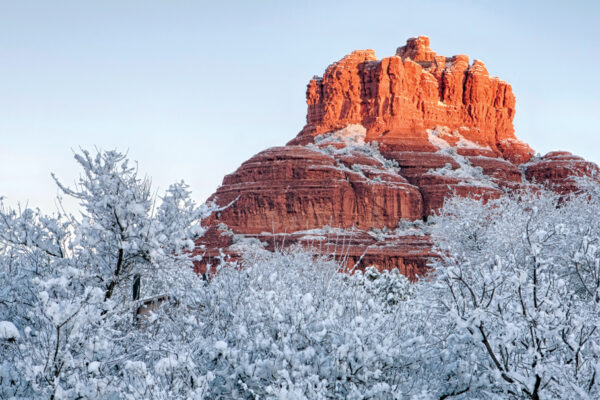WHAT WE CAN LEARN FROM BLUE ZONES ABOUT HEALTHY LIVING
The keys to living a longer life may involve studying what people who live to be 100 or older know about life. The areas where most people reach that triple digit age milestone reside in what are called Blue Zones. The original Blue Zones (Singapore was added as a Blue Zone later on) are five areas of the world – Okinawa, Japan; Sardinia, Italy; Nicoya, Costa Rica; Ikaria, Greece; Loma Linda, California. Residents in these five areas tend to live the longest. “They are places around the world that have the highest propensity and number of centenarians,” says Sarah Kearney, executive director of the Blue Zones Project Scottsdale. The Blue Zones Project Scottsdale’s office opened in December of 2023. “They are actually also living free of chronic disease, illness, fatigue and a variety of other stressors in life. So they’re living better, longer years, not just more years.” The term Blue Zones was first coined by Dan Buettner, a National Geographic Fellow and a journalist. If you’ve heard of Blue Zones before, it might be because there was a Netflix documentary called “Live to 100: Secrets of the Blue Zones” that was released in the summer of 2023. Researchers studied what factors led to residents’ longevity. Here’s what the researchers found and how can you implement these principles into your own routine. These are referred to as the power nine:
THE POWER NINE

Eat wisely and a mostly plant-based diet.
1. EAT WISELY. Sarah tells us that Blue Zone residents aren’t necessarily vegan or vegetarian, but they tend to follow a plant-forward diet. They consumed plenty of fresh green produce. Beans including lentils, soy, black and fava, are also a key component of the centenarian diet. Meat tends to only be consumed about five times per month.

Beans are an important part of a Blue Zones diet.
If you’re looking to try out mostly meatless recipes at a local restaurant, consider eating at VeggieEat. Located in the Village of Oak Creek, this restaurant sells Asian fusion cuisine that’s entirely plant-based. Diners can enjoy menu items like vegan buffalo wings, teriyaki oyster mushrooms and even a Mongolian beef bowl. They’re entirely made with vegetables, and this is a great place to start.

Eat wisely and a mostly plant-based diet.
The Secret Garden Café in Tlaquepaque Arts & Shopping Village also serves veggie-forward dishes like hummus pizza and chile relleno that’s made with a poblano pepper, vegan cheese, tomatoes, black beans, corn, cilantro and avocado served with gluten free rice pilaf.
2. FOLLOW THE 80 PERCENT RULE. Blue Zone residents follow the 80 percent rule and only eat until they’re roughly 80 percent full. They also tend to eat their smallest meal in late afternoon or early evening and stop eating for the remainder of the day.
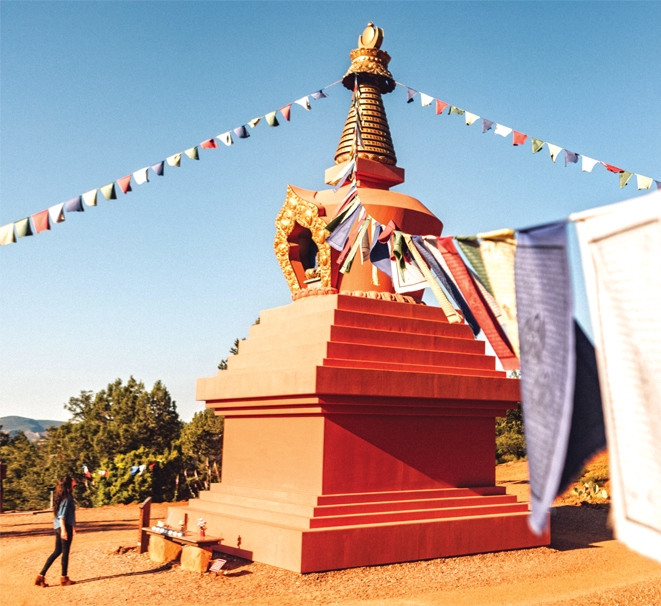
Downshifting or destressing is also an important part of a healthy lifestyle. Meditation – like at Sedona’s Amitabha Stupa and Peace Park – can be a part of that.
3. HAVING A SENSE OF PURPOSE. What exactly does that mean? “Having a sense of purpose, knowing the reason why you wake up every morning could add upwards of seven years to your life,” says Sarah. This can be a challenge for those starting retirement, especially. “They say that the two most dangerous years of the person’s life are the year that they’re born and the year that they retire. That makes a lot of sense in knowing that when you’ve been working for so long … when you retire and you don’t have that same routine and regimen of going to that workplace,” she says. “What is that purpose moving forward? And how are people able to unlock it once they go into retirement?” If your working days are behind you, Sedona is home to plenty of nonprofits and volunteer-lead organizations that could use your help. Being an arts centric community, Sedona also has plenty of groups and classes that are dedicated to the arts.
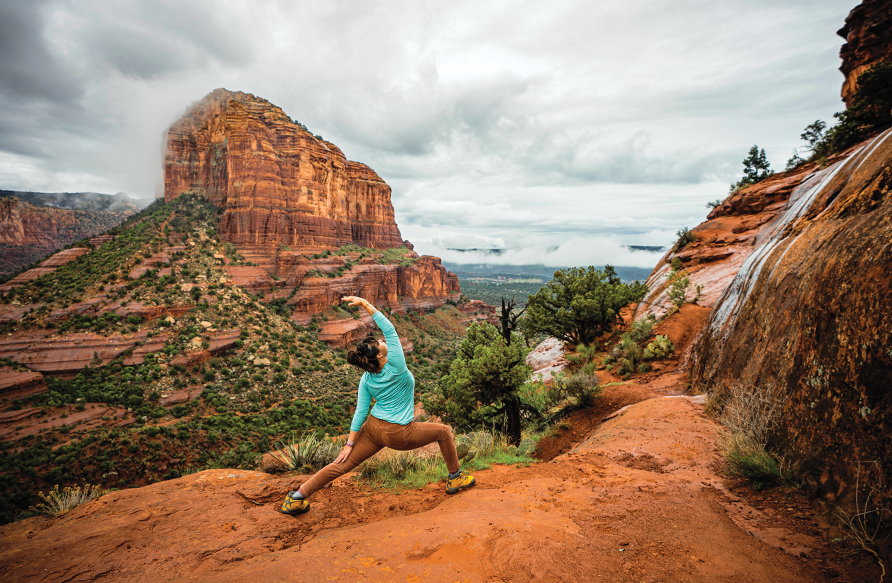
Move naturally. Photo by Dobbsty Photography.
4. MOVE NATURALLY. Exercise is great for our health, of course, but this refers to moving more throughout the day. Maybe it’s taking daily walks or parking farther away when you visit a store. “We’ve seen that in the original Blue Zones, their environments, whether they’re just naturally built on inclines and hills and mountainous regions, these folks are just walking around in and getting a rigorous workout,” says Sarah. Living in a place like Sedona means that you have an abundance of opportunities to move outdoors in a beautiful place. The city is home to more than 200 hiking trails of varying skill levels ranging from tough treks to easy strolls like the paths around Crescent Moon Ranch. If hiking isn’t your thing, mountain biking is another option for you.
5. DOWNSHIFT. Downshifting, according to bluezones.com, refers to the process of decreasing stress. Living a totally stress-free life is pretty impossible, but what people who live Blue Zones know is that taking a few moments to de-stress is key. People in Okinawa remember their ancestors while people in Ikaria take naps. Find what works for you. Maybe it’s taking a yoga class at a studio like Clarity of Heart in the Village of Oak Creek or Sedona Hot Yoga in West Sedona.
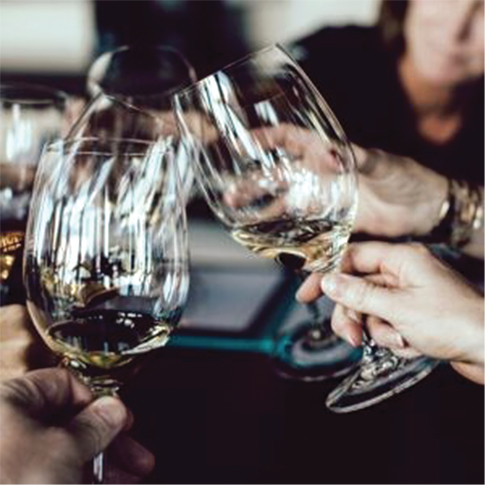
Drinking a glass or two of wine with others daily can have positive health benefits.
6. WINE AT 5 P.M. This is probably the favorite of all the nine principles. This refers to having one or two glasses of wine per day. People in all Blue Zones drink regularly. It’s advised to drink one to two glasses daily with food or friends. Blue Zones recommends Sardinian Cannonnau wine. This type of red wine is particularly rich in antioxidants and is similar to a Grenache grape. Grenache is a grape that grows in Arizona, and you can find Grenache in blends from local wineries like Merkin Vineyards and Page Springs Cellars. It’s important that the drinking is moderate. It doesn’t work if you drink 14 glasses on Saturday. Not that you should. “Wine at five it really is intended to have a glass or two day with friends and food and social camaraderie that comes around there,” says Sarah.
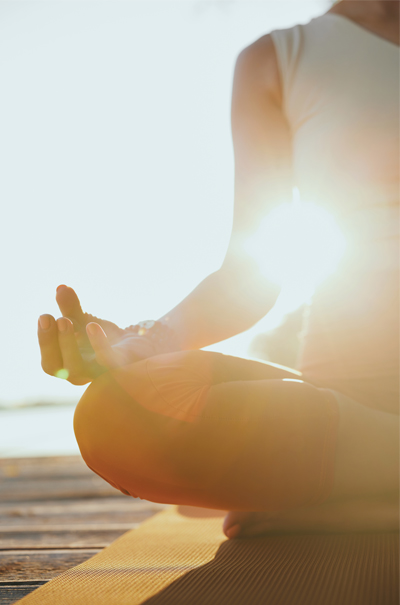
Yoga can be a way to downshift or unwind.
7. BELONGING. Out of the 263 centenarians interviewed, only five didn’t belong to a faith-based organization. Denomination didn’t seem to matter. Their research showed that attending faith-based services four times per month can add four to 14 years of life expectancy. Another group, like say a volunteer group or something similar, could also work. Just find something that matters to you and a group where you can meet other like-minded people.
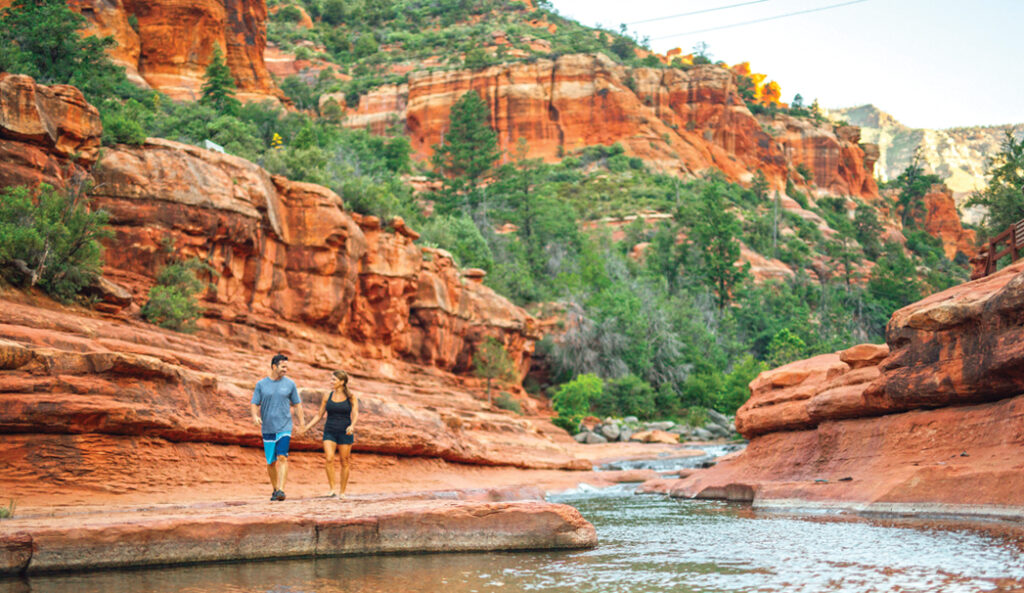
Maintaining relationships is part of leading a healthy life.
8. LOVED ONES FIRST. People in Blue Zones tend to live in close proximity or even with their parents or grandparents and take care of them. They also tend to commit to a life partner and also invest in their children. If you’re close with your family, try to maintain those ties. If you’re not geographically or emotionally close, try to find that group elsewhere.
9. RIGHT TRIBE. Having a strong social network is a key component of health. People who live long lives tend to choose or were born into supportive social circles. For instance, Okinawans set up “moais” or groups of five friends that commit to each other for life.
Although the nearest original Blue Zone to Sedona is in Loma Linda, California, there’s a Blue Zones project that arrived in Scottdale in December of 2023. This is a four-year initiative that seeks to help make Scottsdale healthier by applying Blue Zones health principals. This is a new local chapter of a nation-wide initiative. There are about 75 Blue Zones communities throughout the United States. Some specific examples of how the group plans to do this include by going into schools and providing children with healthier lunch options, making cafeterias at workplaces healthier and even designed Blue Zones parking spaces that are actually farther away. The physical office located in Old Town Scottsdale might host purpose workshops, plant cooking courses and other programming that would be free.


